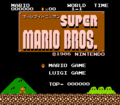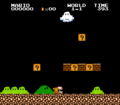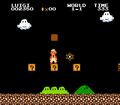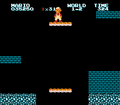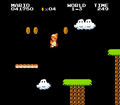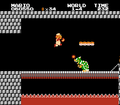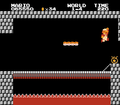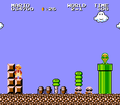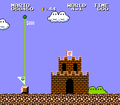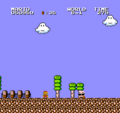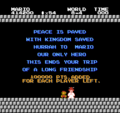All Night Nippon: Super Mario Bros.
The title of this article is official, but it comes from a non-English source. If an acceptable English source is found, then the article should be moved to its appropriate title.
Template:Infobox All Night Nippon Super Mario Bros. (オールナイトニッポン スーパーマリオブラザーズ) is an officially licensed retool of Super Mario Bros.: The Lost Levels, produced in 1986 for the Family Computer Disk System. This version is based on the Japanese radio program All Night Nippon, and it was given out in a contest on the show itself to celebrate the 20th anniversary of the program in the upcoming year. To get the disk, listeners were told to send a postcard with interesting content. If it was not good enough, they would be entered into a raffle. Famicom Tsūshin (Famitsu) and Family Computer Magazine (Famimaga) also gave out 20 copies each to their readers in a lottery.[1] Most winners received their copy in February or March 1987. Initially, only 3000 copies were produced but a limited number were additionally created for mail order due to the high demand.[2] The game was published by Fuji TV, who would go on to publish Yume Kōjō: Doki Doki Panic, which was localized as Super Mario Bros. 2.
Essentially, this game has the physics engine of The Lost Levels but with most of the level designs adapted from Super Mario Bros. along with unique sprite swaps. Like The Lost Levels, there is no 2 Player Game but there is an option to play as Luigi with his physics.
Story
The plot is nearly the same as Super Mario Bros. and Super Mario Bros.: The Lost Levels except that it takes place in the Viva Kingdom (ビバ王国) in the dream world of All Night Nippon. The Turtle Tribe has kidnapped Princess Peach and several radio show hosts while turning the mushroom people into rocks, bricks, and microphones. One host, Sunplaza Nakano-kun, was tricked by King Koopa and transformed into a minion. Mario must rescue Princess Peach who has the power to restore the Viva Kingdom.[3]
Differences
Graphics
- Most of the graphics are from The Lost Levels, although bricks and mountains are drawn like those in Super Mario Bros. Bricks are not shaded, and mountains have smooth slopes instead of jagged slopes. Cloud platforms were replaced with the Super Mushroom platforms but now with segmented stalks.
- Microphones replaced the mushrooms found in the background.
- World 1 was changed to nighttime.
- Little Goombas and Piranha Plants were changed to big-headed caricatures of All Night Nippon's Friday night DJ Sunplaza Nakano-kun and are respectively called Okapī (オカピー) and Pakkun Okapī (パックンオカピー).[4] Okapī is a reference to Sunplaza Nakano's theme song in All Night Nippon.
- The Starman was changed into a Hiranya (ヒランヤ), a symbol popularized by a Japanese radio show called Young Paradise. The Hiranya also resembles the Star of David, a symbol of Judaism.
- The Nippon Broadcasting System, Inc. (the radio station that runs All Night Nippon) logo is found on the flag that is raised when Mario enters a fortress.
- The Nippon Broadcasting System, Inc. logo is also found as the axe that sits behind Bowser.
- The mushroom retainers were changed to the hosts of All Night Nippon, while Princess Peach is dressed as a traditional Japanese princess.
Their identities:
- World 1: Miyuki Nakajima (みゆき)[5]
- World 2: Takaaki Ishibashi (たかあき)[6]
- World 3: Noritake Kinashi (のりたけ)[6]
- World 4: Kyōko Koizumi (KYON2, キョンキョン)[6]
- World 5: Takeshi Kitano (たけし)[6]
- World 6: Daisuke Matsuno (まっちゃん)[7]
- World 7: Hideyuki Nakayama (ひでちゃん)[7]
- World 8: Princess Peach
- Worlds A-C: Unknown (unlisted in the manual)
- World D: Princess Peach
Level order
Most of the levels of the first eight worlds are from Super Mario Bros. but some are from The Lost Levels as shown here:
| All Night Nippon levels | Corresponding Lost Levels | Notes |
|---|---|---|
| 5-3 | 4-3 | Originally 6-3 of VS. Super Mario Bros. |
| 5-4 | 2-4 | |
| 6-4 | 4-4 | |
| 7-2 | 6-2 | Originally 7-2 of VS. |
| 7-3 | 6-3 | Originally 7-3 of VS. |
| 8-4 | 8-4 |
Beating 8-4 will add a star to the title screen (it can fit up to 20 stars) and reveal Hard Mode in which all Okapī are replaced with Buzzy Beetles and all enemies move faster but players must start from World 1-1 as there is no world select option. Hard Mode is not permanent, resetting returns the game to its normal difficulty. Like The Lost Levels, after beating 8-4 eight times (does not matter if with Warp Zones or not), the player gains access to edited versions of Worlds A, B, C, and D. Some of the levels are replaced with those from the first eight worlds of that game as seen here:
| All Night Nippon levels | Corresponding Lost Levels | Notes |
|---|---|---|
| B-1 | 5-1 | Without the Warp Zone and the wind |
| B-3 | 3-3 | |
| C-3 | 7-3 | No wind |
| C-4 | 7-4 | |
| D-1 | 8-1 | This level had a major redesign with the Warp Zone and wind removed and parts of D-2 duplicated. There are two different flagpoles, both leading to D-2. |
Like VS. Super Mario Bros., every level features edits, such as the appearance of more enemies in World 4-1, different maze solutions in 4-4 and 7-4, and the locations of ?s and bricks have been changed. However, these changes are not the same as those found in VS. In addition, all Pakkun Okapī on the ground are green and all hanging ones, introduced in World A, are red but both behave like the red Piranha Plants in The Lost Levels. Two features from The Lost Levels have been removed. Poison Mushrooms have been replaced with regular power-ups. The removal of wind affects the difficulty of the courses they were found in. Super Springs, however, have been kept. World 9 does not exist, even if the game is cleared without using the Warp Zone.
Gallery
The Starman from the game
The mushroom-type platforms in World 1-2 as also seen in The Lost Levels
Mario fighting a fake Bowser
The axe from the game
Both the Little Goomba and Piranha Plant are based on Sunplaza Nakano.
Mario's small form
Princess Peach sprite
Little Goomba (castle)
Trivia
- Other games with a similar concept of Mario meeting Japanese celebrities were found on the Satellaview, with spiritual successors such as BS Super Mario USA, BS Super Mario Collection, and a version of Wario's Woods. Kaettekita Mario Bros. was another similar project.
- Luigi is shown to look exactly like Mario with a blue hat and overalls and a green shirt on the cover of this game. The cover is a modification of artwork for Mario no Daibōken, a 1986 single by Pony Canyon, a subsidiary of Fujisankei Communications Group like Fuji TV.[8] Pony Canyon also released a Super Mario Bros. promotional video under the same title that featured the same cover.[9] That video ends with "GO GO Mario!!", the side B song from that single which was the winner of All Night Nippon's nation-wide contest for lyrics to the Ground Theme. It was from this partnership that the idea for the game was born.
- The Viva Kingdom is named after "Viva Young", the slogan and subtitle of the All Night Nippon radio program. It is also the name of that show's newsletter.
- This game marks the first time Princess Peach has ever done her hair up, predating Super Mario Sunshine by 16 years.
References
- ^ Famitsu #14, December 26, 1986 issue
- ^ Family Computer Disk System: Not for Sale
- ^ Instruction manual, pp.6-7.
- ^ Instruction manual, pp.12-13.
- ^ Instruction manual, p.15.
- ^ a b c d Instruction manual, p.16.
- ^ a b Instruction manual, p.17.
- ^ Mario's Big Adventure/GO GO Mario!!
- ^ Mario's Big Adventure by All Night Nippon Famicom Warriors

